Welcome to the mystical realm of Norse mythology, where gods mingle with mortals and the natural world teems with enchanted beings. From the skies above to the roots of Yggdrasil, animals and creatures are not merely bystanders but pivotal characters in the tapestry of these ancient narratives. Each animal, from Odin’s insightful ravens to Thor’s powerful goats, carries a rich vein of symbolism and reflects the deep connection between the Norse people and their environment.
This post invites you on a journey to explore the legendary animals that roam the Nine Realms, shedding light on their roles and significances in myths that continue to fascinate and inspire. Whether you’re a seasoned follower of Norse paganism or newly enchanted by the allure of Viking lore, there’s a wealth of insight waiting to be discovered.
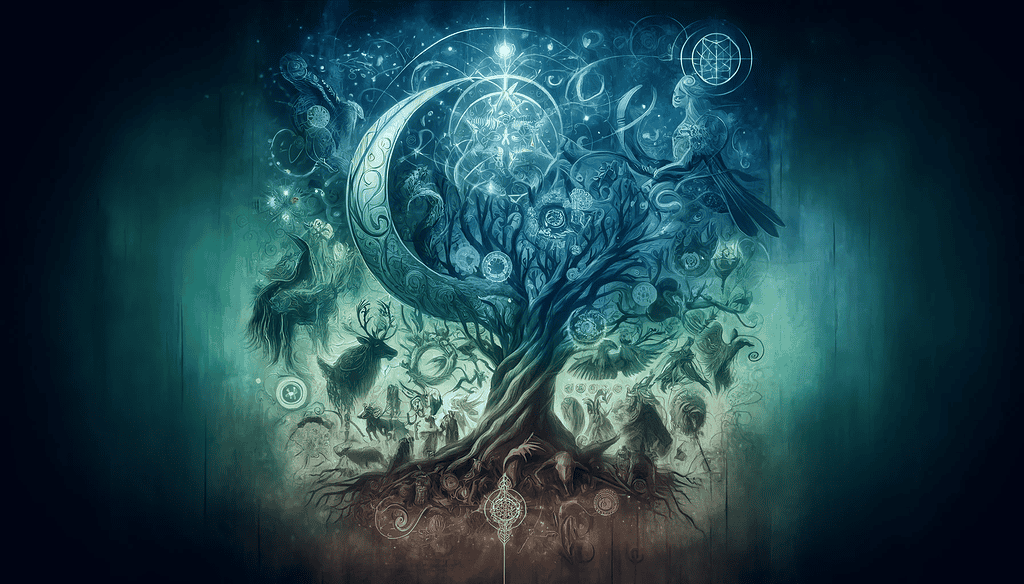
Table of Contents
Ancestral Creatures and Beginnings
Ymir’s Progeny and the Birth of Mythical Beasts
In the shadowy beginnings of the Norse cosmos, the figure of Ymir, the primordial giant, looms large. According to Norse mythology, Ymir was the first being to exist, born from the drops of melting ice in the void of Ginnungagap. His presence marks not just the beginning of life but the complex process from which the world itself was formed. From his massive body, sprung not only the physical world but also a host of mythical creatures that populate the Norse legends.
As the myths recount, Ymir’s body was used by the gods to create the cosmos—an act that signifies the intertwining of the physical and the mystical in Norse culture. His flesh transformed into the earth, his blood into the seas, his bones into mountains, and his hair into trees. However, it is from his eyebrows that Midgard, the human realm, was crafted, showcasing the direct lineage humans share with the divine and mythical.
More fascinating is the birth of various creatures from Ymir’s being. From the maggots that fed on his flesh arose the dwarves, known for their profound craftsmanship and magical abilities. These dwarves would go on to forge many of the gods’ most powerful artifacts, linking them forever to the divine destinies of the Norse pantheon. The giant’s enormous size and strength also find echoes in the giants of Jotunheim, creatures often depicted as foes of the gods yet integral to the world’s balance.
The story of Ymir, therefore, is not just about creation; it’s about the ongoing impact of his progeny in the Norse mythological world. These tales explain not only the origins of the earth and its features but also the continual interaction between the earthly and the divine. For followers of Norse paganism today, Ymir’s story and those of the creatures that arose from him provide a profound connection to the spiritual aspects of the natural world, celebrating a universe alive with the potent forces of creation and destruction.
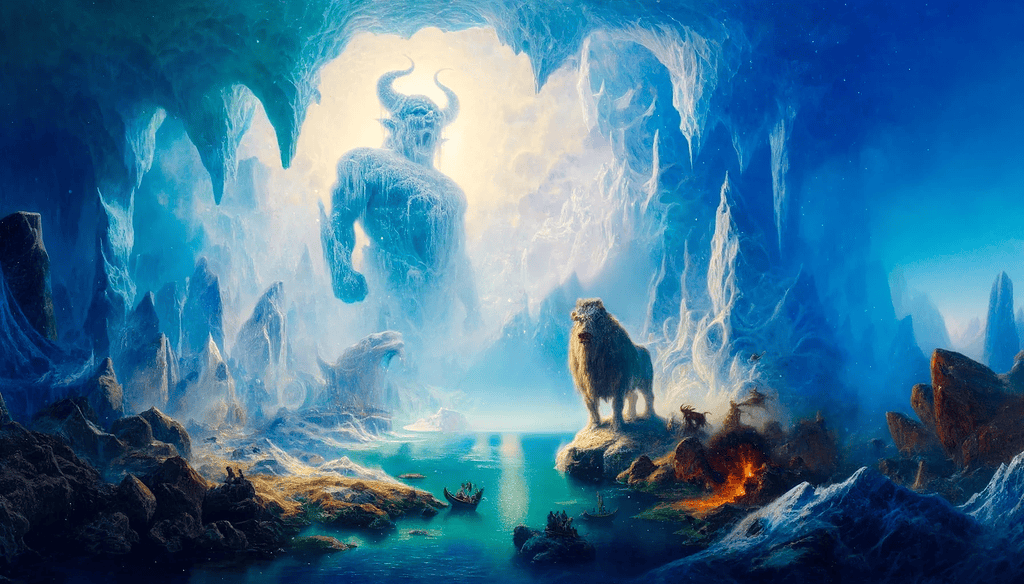
The Divine Companions of the Norse Gods
| Animal Name | Role in Mythology | Symbolic Meaning | Associated God(s) | Key Myths |
|---|---|---|---|---|
| Odin’s Ravens (Huginn and Muninn) | Messengers and spies for Odin | Thought and memory | Odin | Daily flights across the world |
| Freya’s Cats | Pull Freya’s chariot | Love, beauty, and protection | Freya | Freya’s chariot rides |
| Thor’s Goats (Tanngrisnir and Tanngnjóstr) | Pull Thor’s chariot | Strength and resurrection | Thor | Thor’s chariot rides; resurrection after being eaten |
| Fenrir | Bound wolf, central in Ragnarok | Chaos and destruction | Loki (father) | The binding of Fenrir; foretold slayer of Odin |
| Jormungandr (Midgard Serpent) | Encircles the Earth, ensuring the world’s end | The cyclic nature of life and chaos | Loki (father) | The final battle with Thor |
| Sleipnir | The eight-legged steed | Travel and connection between realms | Odin | Sleipnir’s journeys across the realms |
| Skoll and Hati | Chasers of the sun and moon | The inevitable apocalypse | None directly | Their pursuit leading to eclipses |
| Ratatoskr | Messenger running on Yggdrasil | Spread of knowledge and gossip | None directly | Communication between the eagle and Nidhogg |
| Nidhogg | Gnaws at Yggdrasil’s roots | Death, decay, and renewal | None directly | Conflict under Yggdrasil |
Odin’s Loyal Ravens: Huginn and Muninn
In the rich tapestry of Norse mythology, few creatures are as emblematic or as enigmatic as Huginn and Muninn, the two ravens of Odin. These birds are not merely pets but profound symbols linked directly to Odin’s intellectual and spiritual attributes. Huginn, whose name means ‘thought’, and Muninn, translating to ‘memory’, are said to fly across the world during the day. Upon their return, they perch on the god’s shoulders and whisper all they have seen and heard into his ears.
This daily ritual underscores the importance of knowledge and wisdom in Norse culture, particularly the value placed on surveillance and the gathering of intelligence. Odin’s dependency on Huginn and Muninn highlights his quest for knowledge, a theme central to his character and to the Norse pantheon’s interactions with the world. The ravens’ flights can be interpreted as metaphorical quests into the realm of thought and memory, essential for maintaining order and governance in the cosmos.
Their omnipresence also serves as a divine surveillance system, symbolizing the all-seeing nature of Odin who is often associated with foresight and prophesy. Thus, Huginn and Muninn play a critical role not just in mythological narratives but also in illustrating the Norse understanding of the interconnectedness of thought, memory, and divine oversight.
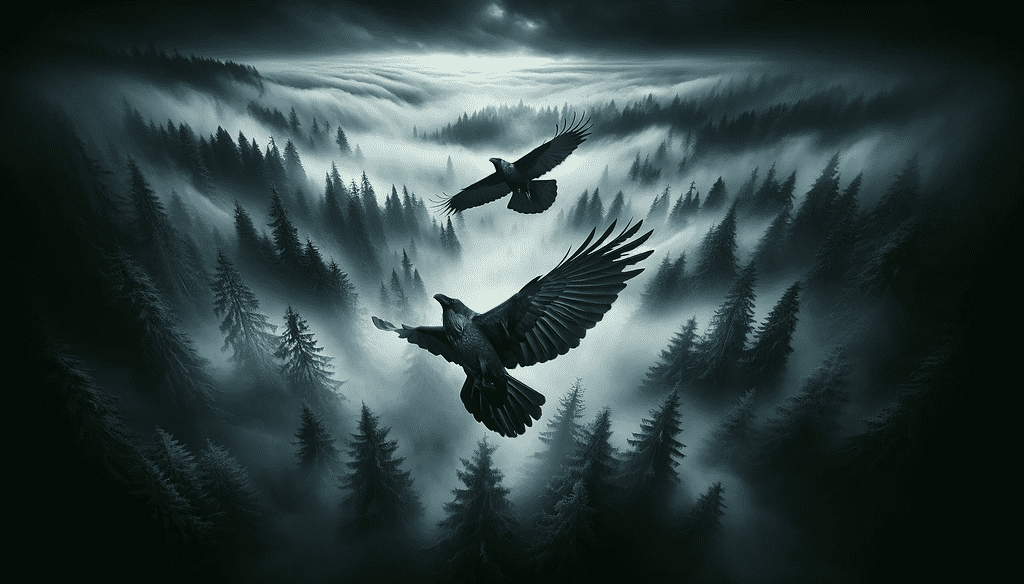
Freya’s Sacred Cats
Freya, the goddess of love, beauty, and fertility, is often depicted with her sacred cats, who pull her chariot. These cats are more than mere divine pets; they are potent symbols of her dominion and attributes. Cats in Norse mythology are creatures that embody grace and independence, qualities that are deeply resonant with Freya’s own characteristics.
The cats’ role in pulling Freya’s chariot also signifies their importance in ritual and celestial events, indicating their integral role in Freya’s divine responsibilities. In Norse society, cats were valued for their vermin control and were seen as good luck, further linking Freya with domestic and everyday comforts, as well as the more profound aspects of love and care.
These animals also emphasize Freya’s connection to the magical and mystical elements of Norse mythology. Cats are often associated with witchcraft and the esoteric in various cultures, and their presence with Freya enhances her portrayal as a powerful sorceress and a formidable deity.
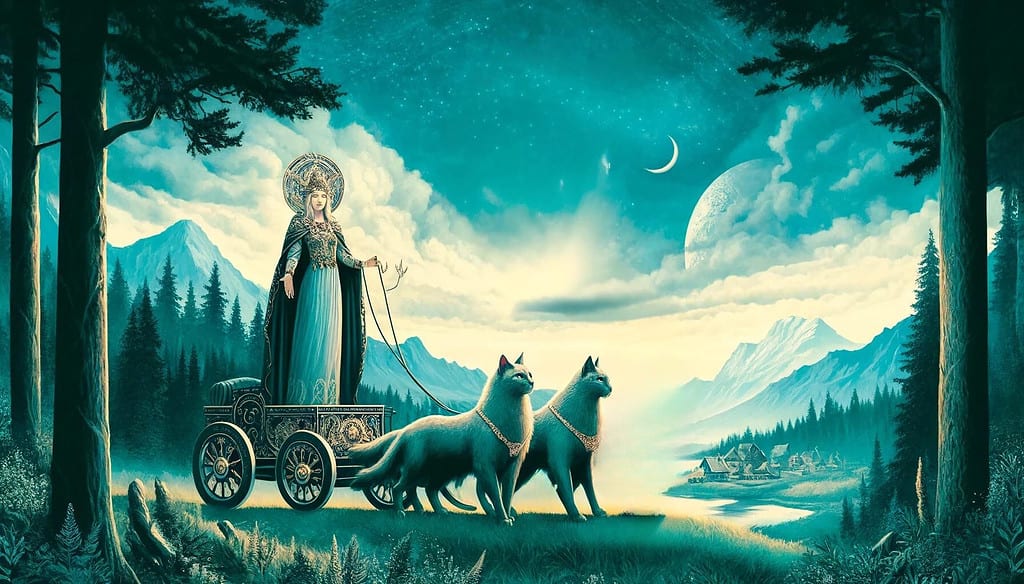
Thor’s Mighty Goats: Tanngrisnir and Tanngnjóstr
Thor, one of the most revered gods in Norse mythology, is well known for his strength and heroism, attributes that are mirrored by his mighty goats, Tanngrisnir and Tanngnjóstr, who pull his chariot. These goats are not only significant for their role in Thor’s cosmic duties but also symbolize resilience and regeneration, echoing Thor’s own abilities as the god of thunder.
According to myths, Thor can consume his goats, only to resurrect them the next day, provided their bones are kept whole. This unique trait underscores themes of death and rebirth, common in Norse mythology, and highlights the cyclical nature of existence. The goats’ ability to come back to life also symbolizes the renewal of nature’s forces, akin to thunderstorms that come and go but leave the world cleansed and refreshed.
Their role in Thor’s mythology extends beyond their functional use; they also signify the raw power and the unstoppable force of the natural elements Thor commands. As creatures who literally carry the thunder god across the skies, they embody the wild, untamable spirit of the storms Thor wields and the protective aura he holds as a deity who guards humanity.

Symbolic Roles and Connections
Through these divine companions—Odin’s ravens, Freya’s cats, and Thor’s goats—Norse mythology integrates the natural and supernatural, offering a window into the ancient Norse worldview that sees the divine not as remote but as intimately connected with the natural world.
These animals not only serve their masters but also carry deeper meanings, reflecting the traits and duties of their respective deities, thus enriching the mythical narratives with layers of symbolism and teaching. Whether as symbols of intellectual pursuit, beauty and domesticity, or strength and renewal, these creatures help bridge the human and the divine, illustrating the complex relationships and beliefs of the ancient Norse.
Mythical Beasts and Their Legendary Tales
Fenrir: The Bound Wolf
In the pantheon of Norse mythology, Fenrir the wolf stands as a towering figure of chaos and destruction. Born of the trickster god Loki and the giantess Angrboda, Fenrir was prophesied to play a pivotal role in Ragnarok, the end of the world. As he grew to a monstrous size, the gods’ fear of his strength and the dire prophecies associated with him led them to bind him. This act of binding, using the magical ribbon Gleipnir, crafted from the sound of a cat’s footsteps and the roots of mountains, among other impossibilities, epitomizes the lengths to which the gods went to stave off their fated demise.
Fenrir’s binding is not just a tale of containment but also one of betrayal and the complexities of fate within Norse mythology. When Fenrir agreed to the gods’ test of the bond, he did so with the condition that one of the gods place their hand in his mouth as a pledge of good faith. Tyr, the god of war, was the only one brave enough to do so, and when Fenrir was bound and could not break free, he bit off Tyr’s hand, signaling the deep mistrust between the gods and the beings they feared. This tale forewarns the inevitable fall of the gods and the chaos that Fenrir will unleash during Ragnarok, where he is destined to slay Odin.
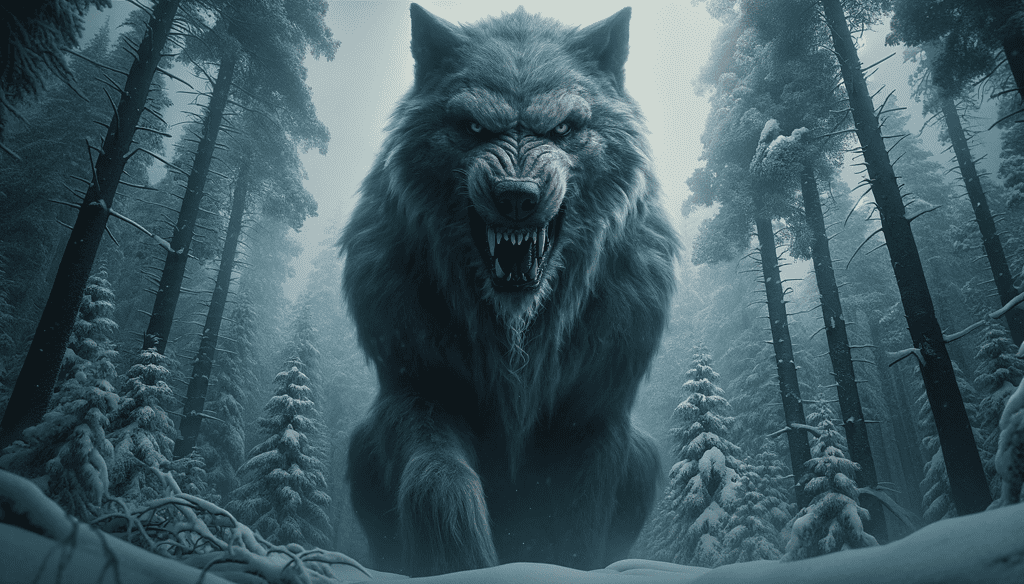
Jormungandr: The Midgard Serpent
Jormungandr, the Midgard Serpent, is another of Loki’s children and a central figure in Norse myths, encapsulating the theme of cyclical conflict and natural order. This immense serpent was thrown into the Earth’s surrounding oceans by Odin, where it grew so large that it could encircle the world and grasp its own tail. Jormungandr’s release from its tail-hold signals the beginning of Ragnarok, underscoring its role as an agent of the apocalypse.
The cyclical battle between Jormungandr and Thor, the god of thunder, highlights their intertwined fates. Their final encounter, prophesied to occur during Ragnarok, ends with Thor killing Jormungandr but succumbing to its venomous breath shortly thereafter. This conflict represents the perpetual struggle between order and chaos, a significant theme in Norse mythology that resonates through the ages. Jormungandr’s embodiment of the world ocean and its eternal battle with Thor also illustrate the Norse view of the natural world as a realm of endless strife and renewal, mirroring the harsh realities of the Scandinavian environment.
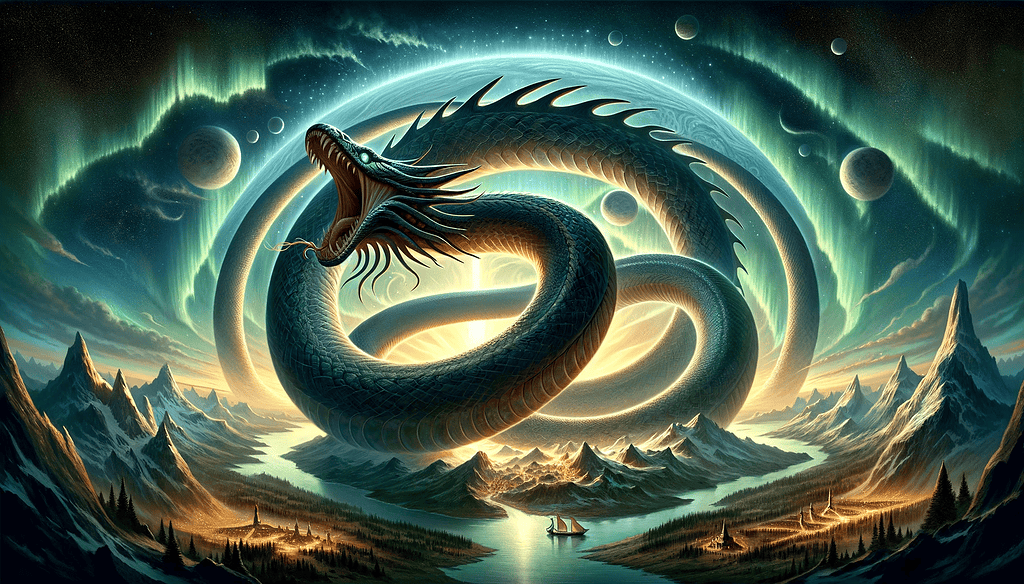
Sleipnir: Odin’s Eight-Legged Steed
Sleipnir, the eight-legged horse, is a marvel of Norse mythology, embodying swiftness and reliability. Born of the god Loki, who transformed into a mare to lure away the stallion Svadilfari, Sleipnir was gifted to Odin. His eight legs symbolize more than mere speed; they are a mark of supernatural ability, allowing him to travel between the nine realms of the Norse cosmology, including the land of the living and the realms of the dead.
Sleipnir is not merely a steed but a bridge between worlds, reflecting Odin’s role as a wanderer among realms, a gatherer of wisdom, and a harbinger of the dead. Sleipnir’s journeys with Odin highlight the deep connectivity of the realms in Norse belief, where gods, humans, and all creatures of myth interact in a multidimensional universe. The stories of Sleipnir often emphasize the themes of loyalty and service, demonstrating his unwavering dedication to Odin, which mirrors the loyalty expected of followers within Norse clans.
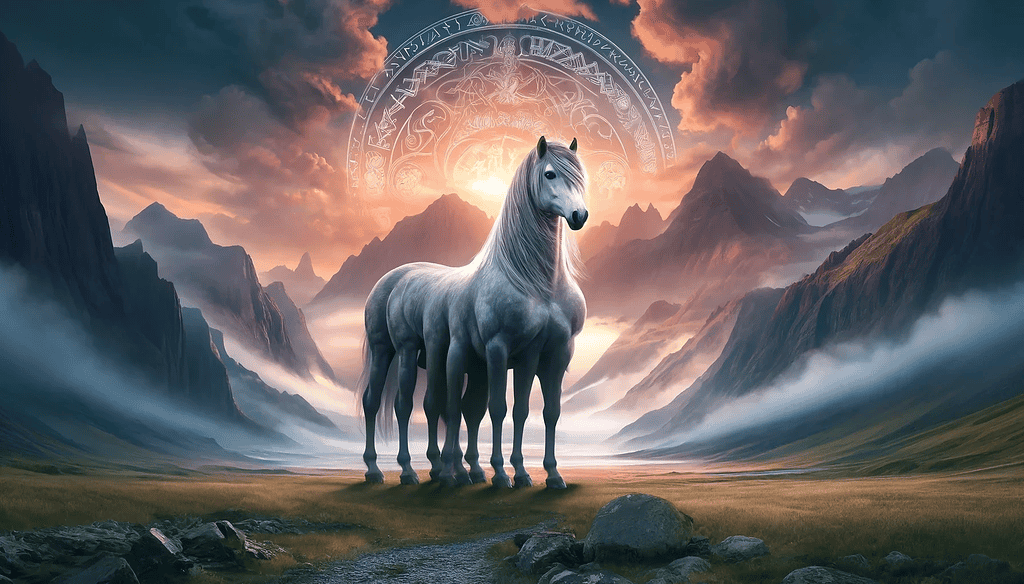
The Cosmic Significance of Mythical Beasts
These tales of Fenrir, Jormungandr, and Sleipnir not only enrich the Norse mythological landscape but also provide insights into the Norse worldview, one filled with awe for the natural world’s power and respect for the inevitable cycles of creation and destruction.
Each beast carries with it profound implications for the balance of the cosmos, serving as both protectors and destroyers, often encapsulating the dual aspects of the gods they serve or oppose. Through these stories, followers of Norse paganism find not only entertainment but also parables of wisdom, strength, loyalty, and the inexorable nature of fate.
Creatures of the Sky and Below
Skoll and Hati: The Celestial Wolves
In the celestial narratives of Norse mythology, Skoll and Hati hold a crucial place as the wolves that chase the sun and moon. These two fearsome beasts are more than mere predators; they are cosmic forces, driving the celestial bodies across the sky and heralding the ultimate doom of the cosmos at Ragnarok.
Skoll, the chaser of the sun, and Hati, who hunts the moon, embody the relentless pursuit that characterizes the Viking understanding of time as a cyclical and fatalistic progression toward an inevitable end. Their chase not only marks the daily cycle of night and day but also mirrors the Norse belief in the cyclical nature of all existence, where every end is a prelude to a new beginning.

Ratatoskr: The Squirrel of Yggdrasil
Ratatoskr, the squirrel running up and down Yggdrasil, the World Tree, plays a pivotal role unlike any typical forest creature. His primary function is as a messenger, carrying insults between the eagle perched atop Yggdrasil and the serpent Nidhogg, gnawing at its roots.
This continuous exchange of messages by Ratatoskr is not merely a piece of mythological trivia; it symbolizes the flow of information and miscommunication that can fuel conflicts, reflecting the complex dynamics of communication within communities. Ratatoskr’s actions illustrate how words can travel and transform within a community, potentially leading to misunderstandings or conflict, a concept that resonates deeply in both ancient and modern societies.
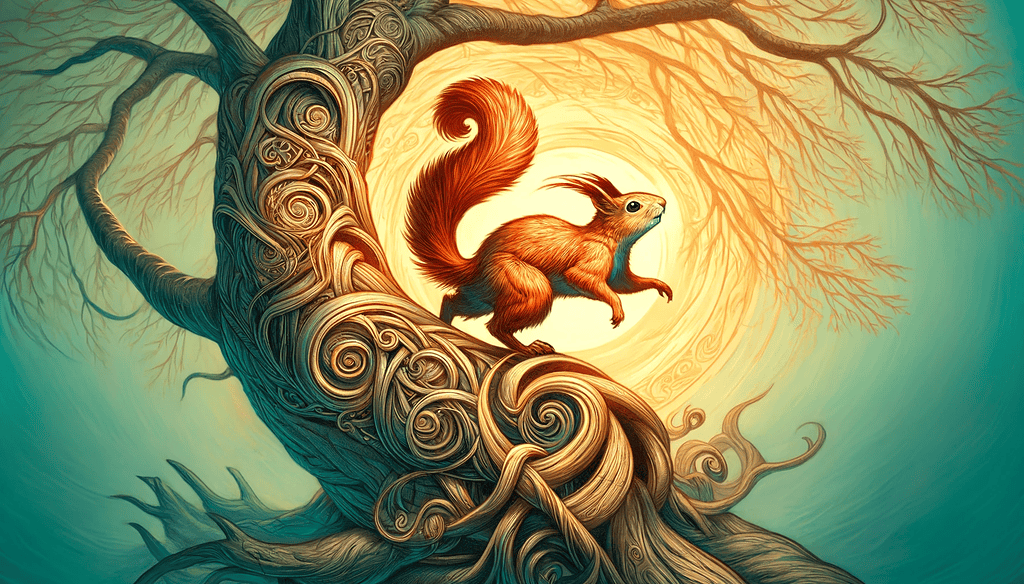
The Symbolic Echoes of Mythic Roles
The stories of Skoll and Hati and Ratatoskr do more than animate the cosmos with thrilling chases and lively disputes. They weave a narrative that reflects the Norse understanding of the world as a place of perpetual tension and conflict, where the forces of creation and destruction are in constant interplay.
These creatures, integral to the mythological framework, underscore a world view that sees life as an endless cycle of renewal and decay, driven by forces both celestial and terrestrial. Through these tales, the ancients conveyed deep truths about the natural order, the inevitability of change, and the power of narrative in shaping reality.
Lesser-Known Beasts and Their Meanings
Dwarves as Mythical Creators
In Norse mythology, dwarves occupy a critical yet often understated role as the master craftsmen of the gods. Renowned for their unrivaled skill in metalwork and magical crafting, dwarves are responsible for creating some of the most iconic and powerful artifacts known to the Norse gods.
These include Odin’s spear Gungnir, Thor’s hammer Mjolnir, and Freyr’s ship Skidbladnir—all pivotal elements that reflect the dwarves’ extraordinary abilities and their integral role in shaping divine narratives. The portrayal of dwarves underscores a key theme in Norse cosmology: the interconnectedness of all beings, where even the smallest and seemingly least significant creatures have roles that are vital to the balance of the cosmos.

Magical Serpents and Dragons
While Jormungandr may be the most well-known serpent in Norse mythology, there are other significant draconic creatures like Nidhogg, a fearsome dragon who gnaws at the roots of Yggdrasil, the World Tree. Nidhogg’s actions represent the constant forces of decay and destruction that threaten the world’s stability.
These serpents and dragons symbolize the inevitable cycle of destruction and renewal that is central to Norse eschatology. They serve as reminders of the fragility and interdependence of all realms, suggesting that even the roots that support the tree of life are subject to the cycles that govern all existence.
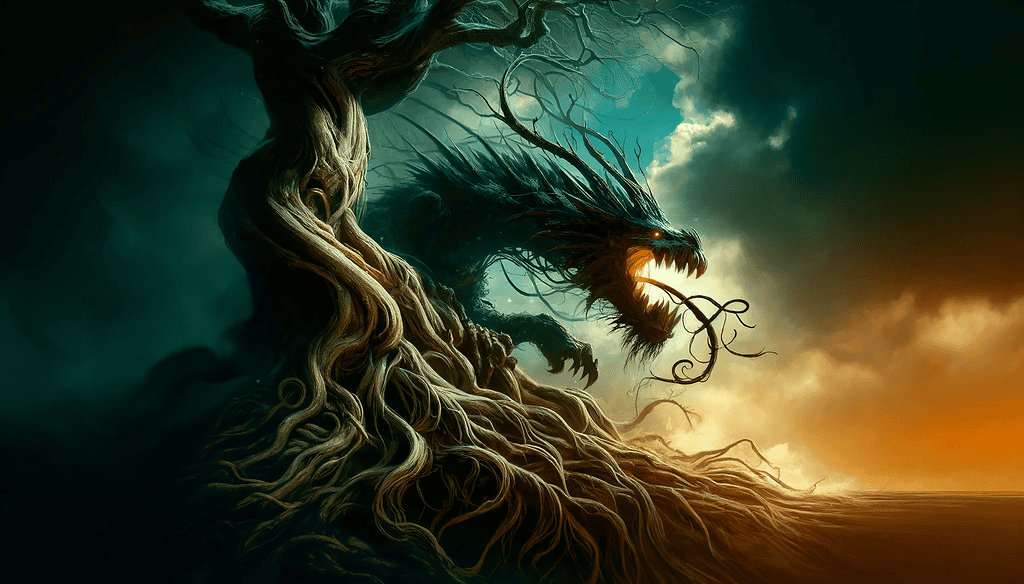
The Weave of Creation and Destruction
These lesser-known creatures, dwarves, serpents, and dragons, significantly enrich the Norse mythological landscape. They embody the deep complexities of a world where creation and destruction coexist as essential and interdependent forces. Through their tales, the ancient Norse expressed a profound understanding of the world’s precarious balance—where the craft of creation by the dwarves contrasts sharply with the destructive nature of serpents and dragons, both of which are crucial to the ongoing saga of the Norse cosmos.
Integration of Animals into Norse Rituals and Symbolism
Animals in Runes and Symbolism
In Norse mythology, animals are not only central to the narratives but also deeply embedded in the runes and symbols used for divination, protection, and ritual. The runes themselves, considered magical and powerful, often carried depictions or references to animals, each symbolizing different aspects of life and the cosmos. For example, the rune Ehwaz, directly associated with horses, symbolizes trust, partnership, and movement, reflecting the deep bond between humans and horses in Norse culture, which was crucial for travel and warfare.
Animals depicted in these runes were believed to impart their characteristics and strengths to the rune’s meaning. This integration of animal symbolism in runes shows a profound connection between the Norse people’s daily lives, their environment, and their spiritual practices. Modern practitioners of Norse paganism often use these symbols not just as historical artifacts but as living connections to their spiritual heritage, embodying the powers and traits of these animals in their rituals and daily practices.
The Continuity of Symbolic Traditions
This enduring symbolism offers a continuous thread between ancient and modern Norse practices, demonstrating the timeless relevance of these animals not just as mythological figures but as integral to understanding and interacting with the spiritual world. Through runes, modern followers find not only guidance and protection but a deeper connection to the Norse gods and the natural forces they embody, illustrating the seamless weave of life, art, and spirituality in Norse tradition.
Reflecting on the Mythical Tapestry of Norse Life and Cosmology
Throughout Norse mythology, animals are not merely background characters but pivotal figures with deep symbolic importance. These creatures—from Odin’s ravens and Freya’s cats to the formidable Fenrir and the mighty Jormungandr—highlight the intertwined nature of the natural world and the divine. Their stories enrich our understanding of Norse cosmology, demonstrating the complex relationships and beliefs that shaped the lives of the Norse people.
As we explore these myths, we gain not only insights into ancient Norse life but also into the values and the spiritual significance that these creatures held. I encourage all who are drawn to these tales to delve deeper into Norse mythology, to uncover the rich layers of meaning and the profound connections between the ancient Norse and the world they revered. This exploration is not just an academic pursuit but a journey into a worldview that offers enduring lessons and reflections on nature, spirituality, and existence.
